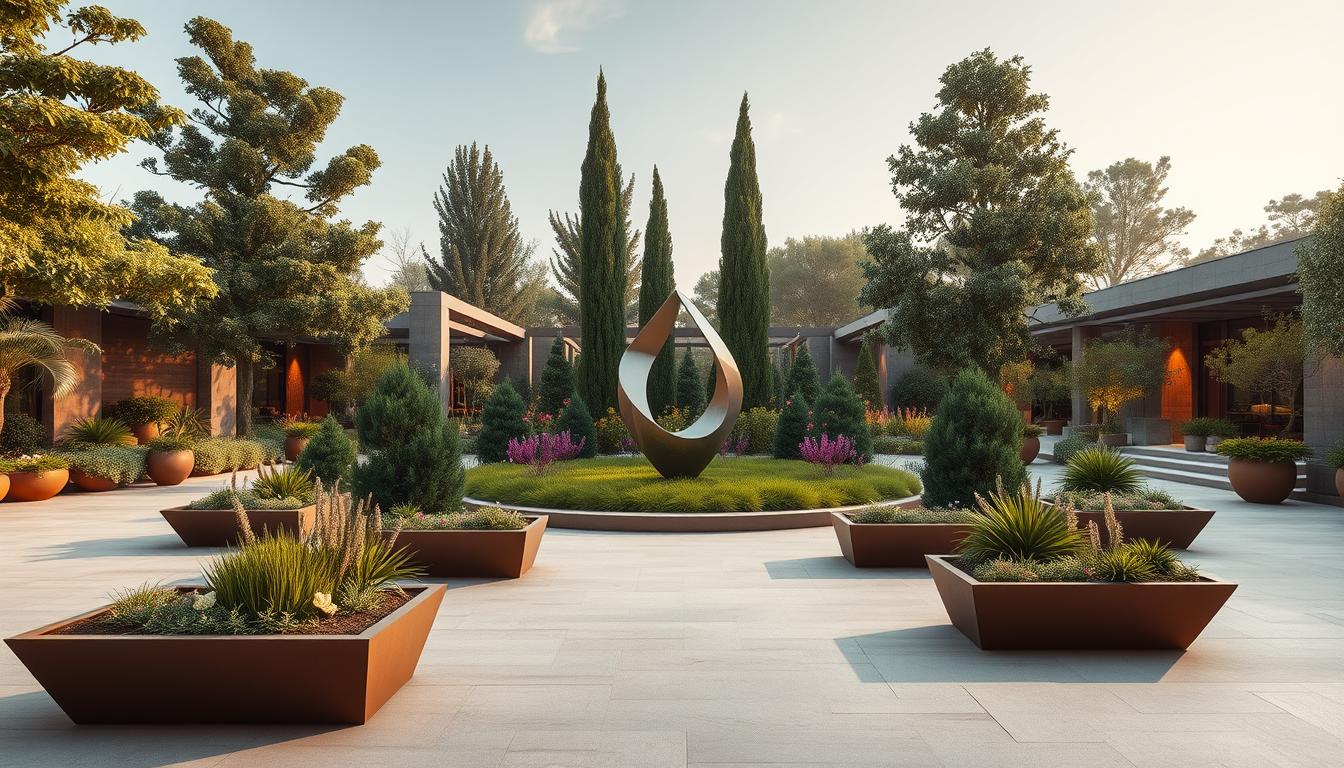Creating a visually stunning outdoor space is easier than you think. By incorporating geometric patterns and organic forms, you can transform any area into a masterpiece. This approach, inspired by experts like Robin Templar Williams and Moira Farnham from the English Gardening School, brings harmony and balance to your surroundings.
Real-world examples, such as Anthony Paul’s water garden and Kat’s Northumberland project, showcase the versatility of this method. Whether you’re working with a narrow yard or a sprawling lawn, this design philosophy adapts effortlessly. It also shines across seasons, as seen in Kat’s winter garden photos.
This method isn’t just for professionals. DIY enthusiasts can also explore simple techniques like using circles, rectangles, and negative space to create visual interest. Even kid-friendly projects, like paper shape collages, can spark creativity. The possibilities are endless, and the results are always inspiring.
Key Takeaways
- Shape-based design uses geometric patterns and organic forms for balance.
- Experts like Robin Templar Williams and Moira Farnham inspire this approach.
- Real-world examples include Anthony Paul’s water garden and Kat’s Northumberland project.
- This method works well in narrow spaces and across all seasons.
- DIY enthusiasts can experiment with circles, rectangles, and negative space.
- Kid-friendly projects, like paper shape collages, add a fun element.
- Encourages creative experimentation for both professionals and beginners.
What is a Garden of Shapes?
By blending geometric and organic forms, you can redefine any outdoor area. This approach focuses on intentional shape arrangements, creating a harmonious and balanced space. Unlike traditional edge-focused planting schemes, this method emphasizes the interplay between positive and negative space.
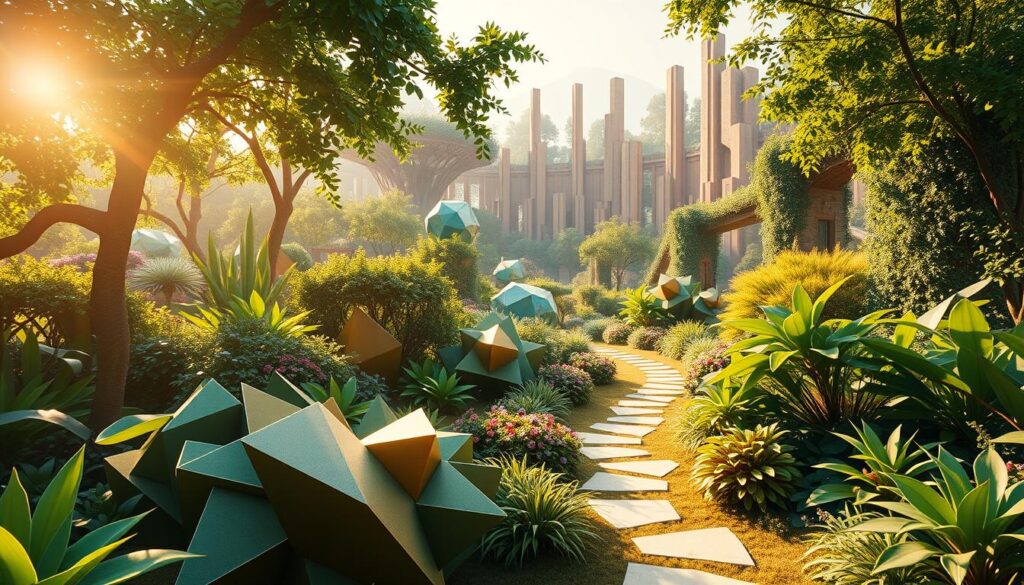
Robin Templar Williams, a renowned designer, advocates for ignoring property lines to achieve a seamless flow. This philosophy encourages creativity and breaks the boundaries of conventional design. Kat’s photographic documentation of seasonal changes further highlights how shapes evolve throughout the year, adding dynamic interest.
The concept of “garden rooms” connected by pathways is another key element. These rooms create distinct areas within a larger space, each with its own unique character. Historical inspiration can be drawn from Mary Forrer Peirce’s Growing Flowers artwork, which beautifully captures the essence of shape-based design.
For beginners, a simple paper shape collage exercise can spark ideas. This activity helps visualize how different forms interact. Shapes also create optical illusions, such as making narrow spaces appear wider. Elevation changes add a 3D dimension, enhancing the overall design.
| Element | Description |
|---|---|
| Geometric Patterns | Squares, circles, and rectangles for structure. |
| Organic Forms | Curves and spirals for a natural feel. |
| Positive/Negative Space | Balanced interplay for visual interest. |
| Seasonal Changes | Dynamic transformations throughout the year. |
This design philosophy is versatile, compatible with modern, cottage, and other styles. Whether you’re a professional or a DIY enthusiast, experimenting with shapes can yield stunning results.
Why Choose Geometric Patterns for Your Garden?
Geometric patterns bring structure and creativity to any outdoor space. They help define areas, create visual interest, and add a modern touch. Whether you’re working with a small patio or a large lawn, these designs can transform your environment into a cohesive and stylish retreat.
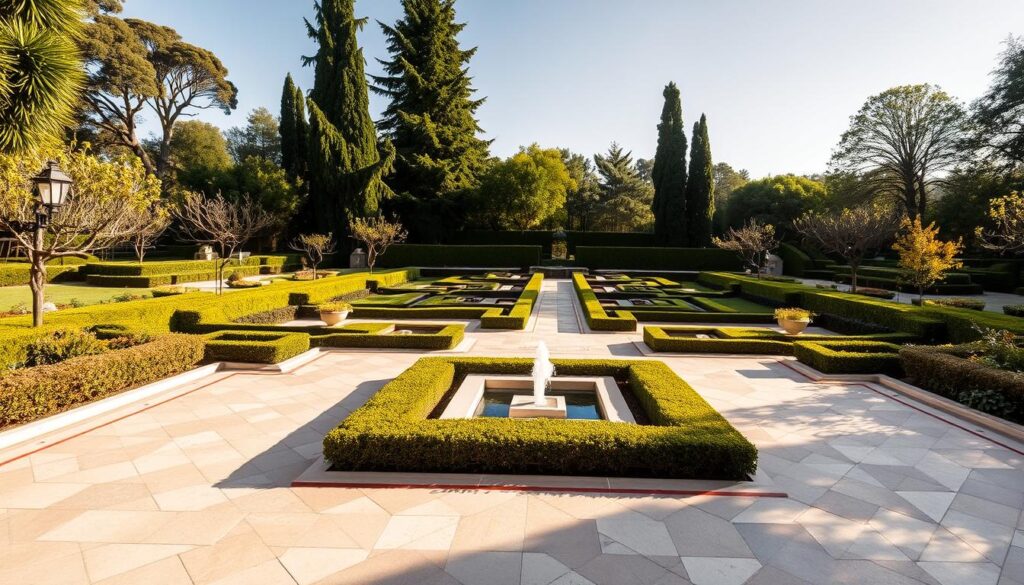
The Role of Positive and Negative Shapes
Positive shapes, like planting beds, and negative shapes, such as patios or pathways, work together to create balance. This interplay is essential for a harmonious design. For example, Robin Templar Williams teaches students to overcome “edge fixation” by focusing on the entire space rather than just the borders.
Kat’s Baptisia example shows how seasonal changes can shift the perception of these shapes. In winter, the stark contrast between positive and negative spaces becomes more pronounced, adding dynamic interest. This approach not only enhances aesthetics but also maximizes usable space.
Ignoring Property Lines for Better Design
One innovative strategy is to ignore property lines when planning your layout. This technique, championed by Robin Templar Williams, creates a seamless flow and expands the visual view. A case study of a 45° grid layout demonstrates how this method can make a narrow area feel more spacious.
Anthony Paul’s modern water garden is another excellent example. By using water as a shaping element, he highlights the importance of intentional spatial organization. This design not only looks stunning but also has a calming psychological impact.
For beginners, a simple exercise like cutting paper shapes can help visualize layouts. This activity encourages creativity and provides a hands-on way to experiment with design principles. Smartphone photography can also be a useful tool for planning and refining your ideas.
How to Start Designing Your Garden of Shapes
Designing with simple forms can transform your outdoor area into a structured yet creative space. Begin by focusing on basic shapes like rectangles, circles, and squares. These elements provide a foundation for building patterns that are both visually appealing and functional.
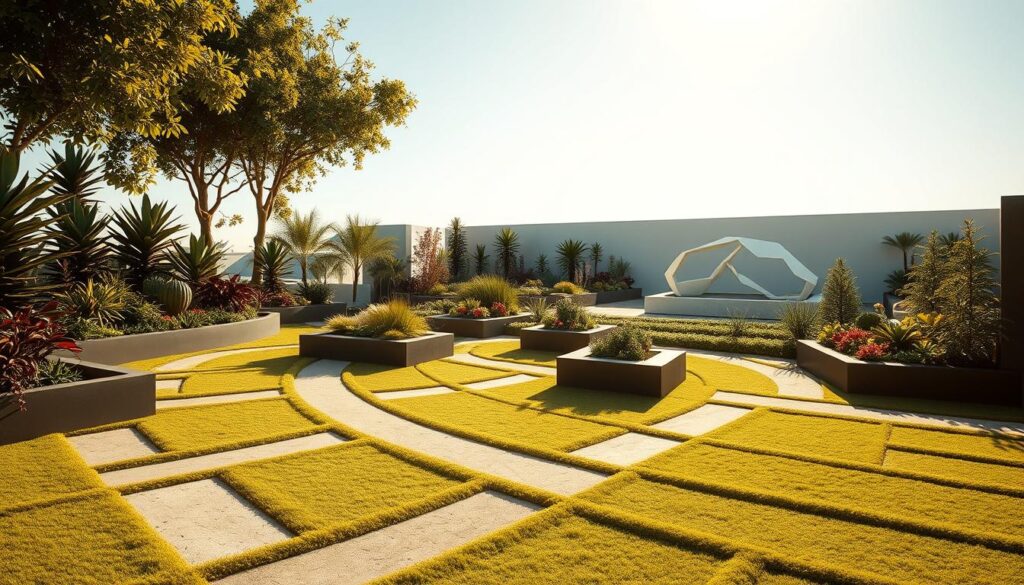
Using Simple Shapes to Create Patterns
Start by sketching your ideas on paper or using a garden app. A rectangle can define planting beds, while circles add softness to pathways. Combining these forms creates a balanced layout. For example, a 45° grid with half-circles and squares can make narrow spaces feel more open.
Elevation changes, like mounding or digging, add depth to your design. This technique, often taught at the Tower Hill Botanic Garden seminar, helps define different areas. Use materials like stone, gravel, or plants to enhance the texture and contrast.
Experimenting with Layouts
Try different layouts to see what works best for your space. Here are four variations to consider:
| Layout | Description |
|---|---|
| Single Shape Focus | Use one shape, like a rectangle, as the centerpiece. |
| Mixed Patterns | Combine circles and squares for dynamic interest. |
| Vertical Elements | Add structures like trellises or sunflowers for height. |
| Zoned Areas | Divide your space into distinct zones with pathways. |
Transitioning between zones can be seamless with thoughtful planning. Use plants or materials to guide the flow. For family-friendly projects, try using safety scissors and construction paper to create a paper collage. This helps visualize your ideas before committing to the design.
“Design is not just about aesthetics; it’s about creating a space that feels right.”
Practical considerations like drainage are crucial, especially in sunken areas. Augmented reality apps can also help preview your design in real-time. With these tips, you’re ready to start shaping your outdoor space into a masterpiece.
Incorporating Plants and Features
Transform your outdoor area with thoughtful plant choices and functional features. The right combination of plants and design elements can create a cohesive and visually appealing space. From structural plants like Baptisia to water features and sculptures, every detail matters.
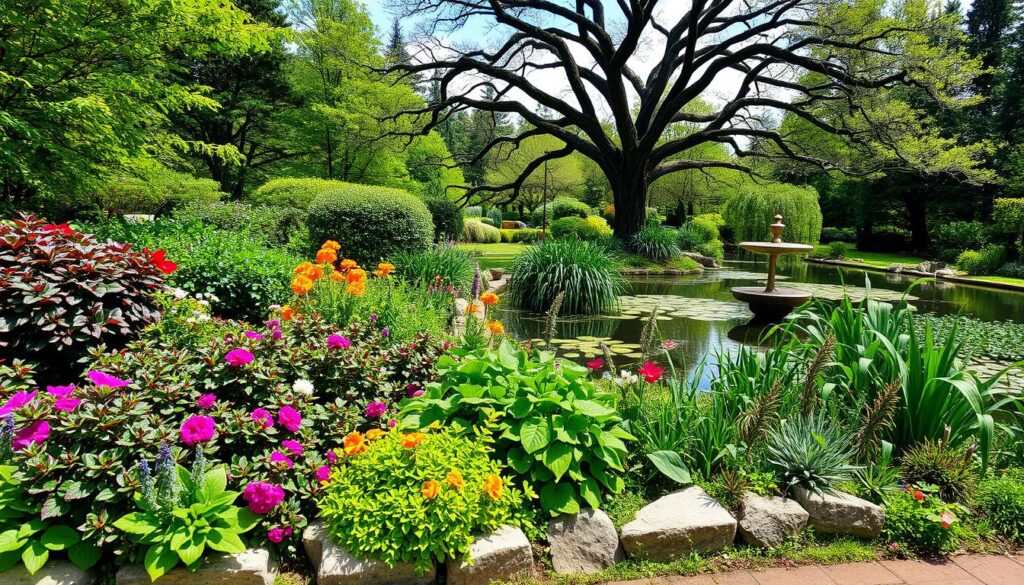
Choosing the Right Plants
Selecting plants that define shapes is key to a successful design. Baptisia, for example, offers structural interest throughout the year. Its upright form works well in circular beds, creating a focal point. Peonies and moon flowers add softness and seasonal color, enhancing the overall layout.
Evergreen plants maintain their shape year-round, while deciduous varieties change with the seasons. Consider both for dynamic interest. For privacy, shaped hedges are both functional and beautiful. They create natural screens while adding texture to your space.
Edible plants, like herb spirals, are another great option. They combine practicality with design, adding a unique twist to your layout. Wildlife-friendly plants, such as those with seed heads, also attract birds and pollinators, enriching your outdoor experience.
Adding Functional Elements
Functional features like water elements and sculptures can elevate your design. Anthony Paul’s modern water garden is a perfect example. Water features serve as focal shapes, adding movement and tranquility to the space.
Metal sculptures provide winter interest, especially when plants are dormant. Geometric trellises are another versatile option. They support climbing plants while adding structure to your design. Training vines on these trellises creates living walls of greenery.
For personalized advice, consider submitting photos to GPOD. This platform offers tailored recommendations based on your unique space and needs.
| Element | Benefit |
|---|---|
| Baptisia | Structural interest year-round |
| Peonies | Seasonal color and softness |
| Water Features | Movement and tranquility |
| Shaped Hedges | Privacy and texture |
“A well-designed space balances beauty and functionality, creating harmony in every detail.”
For more inspiration on blending design and practicality, explore boho farmhouse decor ideas. These tips can help you create a space that’s both stylish and functional.
Examples of Gardens of Shapes
Exploring real-world examples can inspire your own creative outdoor designs. From reflecting pools to seasonal photography, these projects showcase how intentional layouts can transform any space. Let’s dive into two standout examples that capture the essence of this approach.
Modern Water Garden by Anthony Paul
Anthony Paul’s water garden is a masterclass in using negative space. Reflecting pools create a sense of calm and attention to detail. The interplay between water and surrounding plants highlights the importance of balance in design.
This project demonstrates how water can be a shaping element. It adds movement and tranquility, making the space feel alive. For those inspired by this view, consider incorporating water features into your own layouts.
Kat’s Seasonal Photography in Northumberland
Kat’s documentation of her outdoor space throughout the year is a testament to the dynamic nature of design. Her columbine and morning glory arrangements shift with the seasons, offering fresh perspectives. Side-by-side comparisons reveal how colors and shapes interact over time.
Smartphone photography plays a key role in capturing these changes. Kat’s tips include focusing on natural light and experimenting with angles. Her insect-friendly sunflower display is another highlight, attracting pollinators while adding visual interest.
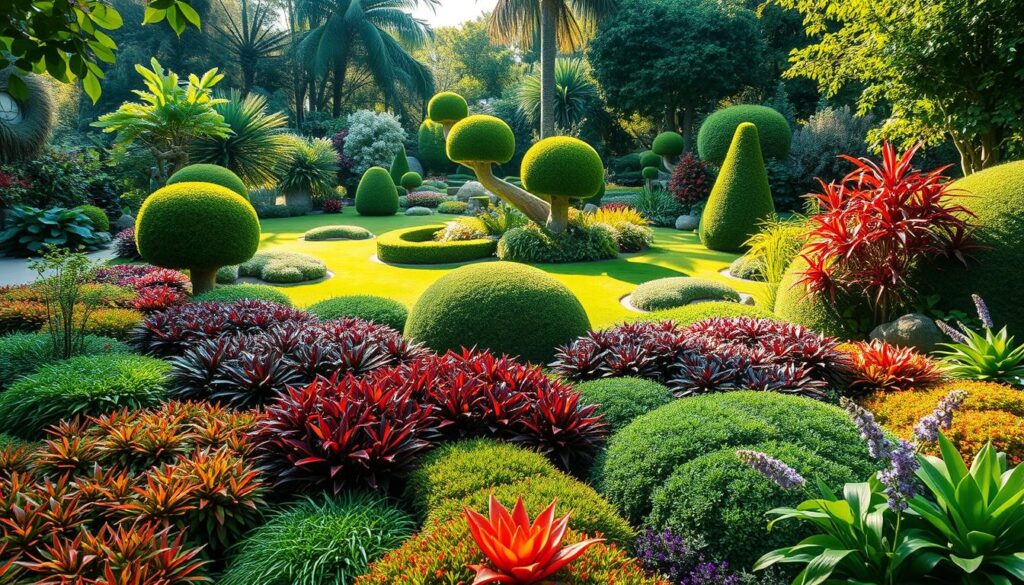
“Every season brings new opportunities to see your space in a different light.”
Professional vs. DIY Approaches
Whether you’re a professional or a DIY enthusiast, there’s something to learn from these examples. Anthony Paul’s meticulous planning contrasts with Kat’s organic, evolving style. Both approaches yield stunning results, proving that creativity knows no bounds.
For those starting today, a children’s paper project can be a fun way to visualize ideas. Cutting and arranging paper shapes helps explore layouts before committing to a design. This hands-on activity is perfect for families or beginners.
| Project | Key Features |
|---|---|
| Anthony Paul’s Water Garden | Reflecting pools, negative space, calming effect |
| Kat’s Northumberland Space | Seasonal photography, columbine arrangements, insect-friendly plants |
| Paper Shape Project | Hands-on activity, ideal for beginners and families |
For more inspiration, consider submitting your own designs to GPOD. Their guidelines help refine your ideas and connect you with a community of like-minded enthusiasts. Explore New Gen Living for additional tips on blending creativity and functionality in your outdoor space.
Tips for Maintaining Your Garden of Shapes
Keeping your outdoor space in top shape requires consistent care and attention. Whether you’re a seasoned designer or a DIY enthusiast, these tips will help you preserve the beauty and functionality of your creative layouts. From seasonal care to handling awkward spaces, here’s how to maintain your masterpiece.

Seasonal Care
Each season brings unique challenges and opportunities. In winter, Kat’s structure preservation methods, like covering delicate plants, ensure your design remains intact. Spring is the perfect time for pruning geometric hedges to maintain their sharp edges. Summer requires regular watering and monitoring for pests, while fall is ideal for planting annuals to refresh your layout.
Robin’s edge planting solutions also help define borders year-round. Elevation maintenance techniques, such as checking retaining walls for erosion, prevent long-term damage. A monthly checklist ensures you stay on top of tasks like addressing frost heave in paved areas and winterizing water features.
Dealing with Awkward Spaces
Awkward spaces can be tricky, but they also offer creative opportunities. Camouflaging utilities with shaped plantings, like low shrubs or decorative grasses, turns eyesores into design features. Repeating shape patterns through propagation, such as dividing overgrown Baptisia clusters, keeps your layout cohesive.
For narrow yards, consider updating layouts with annual plantings to add variety. Leveraging garden apps for maintenance tracking saves time and ensures nothing is overlooked. These tools also help you visualize changes before implementing them.
| Task | Best Time |
|---|---|
| Pruning Hedges | Spring |
| Winterizing Water Features | Late Fall |
| Planting Annuals | Fall |
| Checking Retaining Walls | Spring and Fall |
For those looking to deepen their knowledge, courses on outdoor design maintenance are a great resource. They provide hands-on techniques and expert advice tailored to your needs. With these tips, your outdoor space will remain a source of pride and joy for years to come.
Conclusion
Start transforming your outdoor space today with simple yet impactful design techniques. Inspired by Robin Templar Williams and Kat’s seasonal photography, these methods are accessible to everyone, regardless of skill level. Begin with a hands-on paper shape exercise to visualize your ideas before diving into the real project.
Join the GPOD community to share your progress and gain inspiration from others. Seasonal shape guides are coming soon, offering fresh ideas for every time of year. Remember, ignoring property lines can unlock creative potential and expand your design possibilities.
Mary Forrer Peirce’s artistic legacy reminds us that beauty lies in intentional arrangements. Explore our recommended tools and plants list to bring your vision to life. Your space has the potential to become a masterpiece—submit your photos to GPOD and showcase your transformation!

